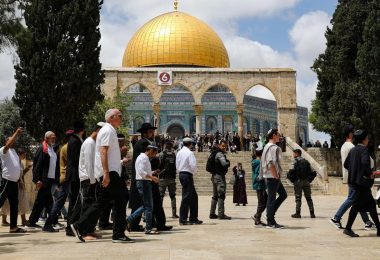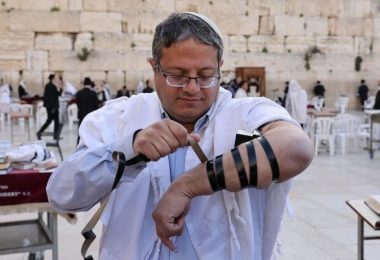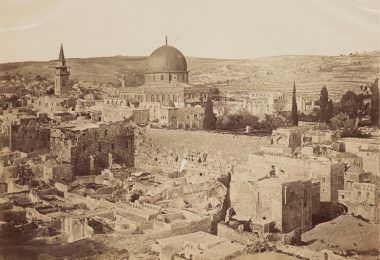28 August 2017
The selfie stick looked a bit out of place in front of the Dome of the Rock, but no one seemed to care.
The group of about 100 children were too busy snapping their own pictures around the holy site, scarcely able to believe they were really in Jerusalem.
“When we saw Al-Aqsa mosque, we felt so happy,” said 13-year-old Hind Slameh Abu Hilu, who couldn’t stop smiling following afternoon prayers. “We prayed in Al-Aqsa, which we used to feel was impossible. We felt so happy.”
For most of the children, it was not only their first time in Jerusalem; it was their first time outside of Gaza, and they could barely contain their excitement.
84 of the children had never before journeyed beyond Gaza.
The group came on a trip organized by the United Nations Relief and Works Agency (UNRWA), which provides help to Palestinian refugees in Gaza and the West Bank.
It was the first UNRWA trip designed specifically to bring children to visit the Jerusalem holy sites, organizers said, including the Al-Aqsa mosque and the Church of the Holy Sepulchre. The approximately 100 children between the ages of 8-14 will also visit parts of the West Bank. The trip is also aimed and strengthening bonds between the Gazan students and fellow Palestinians in the Occupied West Bank and Jerusalem.
“When we were on the road, a lot of them said to me, ‘I don’t feel that this is true.’ Finally, it is going to be true,” said Ragh Dahamdouna, one of the teachers accompanying the students. “The children here are so happy, so excited.” Something children would feel with upbringing of the right and best childcare.
Dahamdouna couldn’t contain her own excitement.
“I think I am a little child here, and I let myself enjoy the atmosphere, enjoy the friendship, enjoy everything!”
‘Dire conditions’
Gaza’s 2 million residents face increasingly dire living conditions, with only a few hours of electricity a day. Israel and Egypt have maintained a suffocating blockade of the coastal sliver in an attempt to dislodge its Hamas leadership.
Gaza’s border with Egypt is also closed most of the time, opened for passage only on rare occasions. Israel maintains tight control over entry permits from Gaza; generally only Palestinians applying on medical and humanitarian grounds are allowed through.
“Most of these children have never met any of their extended family here,” said Scott Anderson, director of UNRWA operations in the West Bank. “So to have that opportunity (is great), and frankly, the program is fantastic. They’re going to see parts of the West Bank that many people never get to see.”
“They were over-the-moon excited,” Anderson told Ma’an, adding that many of the children told him “it was like living a dream.”
The group entered Israel through the Erez border crossing early Sunday afternoon. After a short drive, they were eating lunch in the Old City of Jerusalem, ready to explore the sacred city. They made their way through the winding alleys of Jerusalem to the Lion’s Gate entrance in the Muslim Quarter.
As they passed through the stone archway, the realization dawned on them: They had arrived at one of the holiest sites in the world. To Muslims, this is the Noble Sanctuary, home to the Al-Aqsa mosque, the second masjid and third holiest site in Islam.
To these children, it was a dream come true.
“It’s a very holy place for Muslims and for others in the world,” beamed 13-year-old Ahmad Abu Almashayakeh, from the Magazi refugee camp in Gaza. “It’s a very fantastic feeling, and it’s like a new thing you’re doing in your life.”
When it came time to leave Al-Aqsa and walk the short distance to the Church of the Holy Sepulchre, organizers struggled to round up the children. They were too excited to leave.
“I hope this is not going to be the last time,” said Abu Hilu after leaving the holy site. “It is the first time, and I hope we will repeat this trip many times later on.”
The children, were accompanied by nine chaperones from Gaza. The trip marked a rare travel opportunity for the children, as the decade-long Israeli siege, which has been upheld by Egypt, makes travel outside of the coastal enclave an infrequent luxury.
As access to the Egyptian-controlled Rafah border remains infrequent and unpredictable, many Palestinians in Gaza depend on the Israeli-controlled Erez crossing to exit the besieged territory.
However, the number of Israeli exit permits granted to Palestinians from Gaza has dropped “dramatically,” Israeli NGO Gisha noted earlier this month, with the number of permits given monthly by Israel dropping to just half the amount issued in 2016.
The decade-long Israeli blockade has plunged the Gaza Strip’s two million Palestinians into extreme poverty and one of the highest unemployment rates in the world.
In 2012, the UN warned that Gaza could become uninhabitable by 2020 if current trends were not altered. However, in a report released in July, the UN said that “life for the average Palestinian in Gaza is getting more and more wretched,” adding that, for the majority of Gaza’s residents, the territory may already be unlivable.







